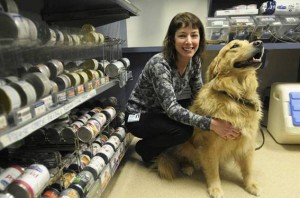Is Your Pet Overweight?
In previous blog posts, we discussed risk factors for osteoarthritis and how to reduce or delay the onset of osteoarthritis. In both of those posts, we mentioned that a pet being overweight may contribute to his/her development of osteoarthritis.
Unfortunately, it is estimated that approximately 56% of dogs and 60% of cats in the United States are overweight or obese. But how can you tell if your pet is overweight? Below are some tools to help you determine if your pet is overweight.
One way to tell if your pet is overweight is to determine your pet’s body condition score. You can look this up online and find pictures of what your pet’s ideal body should look like. Below is an example of a body score chart for dogs and cats. What score does your pet receive? If you’re not sure, your veterinarian can help to determine your pet’s body condition score.

Notice in the chart above, the pictures show the view of dogs and cats from the top. Looking at your pet from above can be a helpful way to determine if your pet is overweight. Like the chart above says, you should be able to feel your pet’s ribs but not see them. There should be a slight layer of fat over your pet’s ribs. Your pet should also taper at their waist- a bit like an hourglass shape.
Another sign that your pet is overweight is reduced stamina or increased lethargy. Is your dog panting more or not able to walk as far? Is your cat unable to jump up on furniture? Note that these signs can also indicate other, more serious conditions so if you’re concerned about your pet’s behavior, take him/her to the vet.
Nobody wants to be told that their pet is overweight. But it puts your pet at risk of many diseases so it should not be ignored. In addition to osteoarthritis, obesity can lead to serious health conditions such as diabetes and cardiovascular disease. Alternatively, your pet may be obese as a result of a health problem such as hypothyroidism or Cushing’s disease.
If you believe your pet may be overweight, a visit to the veterinarian is probably in order. Luckily, there are steps you can take to ensure your pet maintains an ideal weight or to help your pet lose weight. Your vet can rule out underlying diseases and also help you establish a nutritionally sound diet as well as an exercise routine that is appropriate for your buddy.









